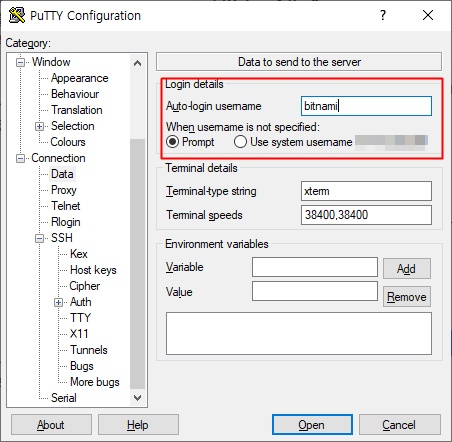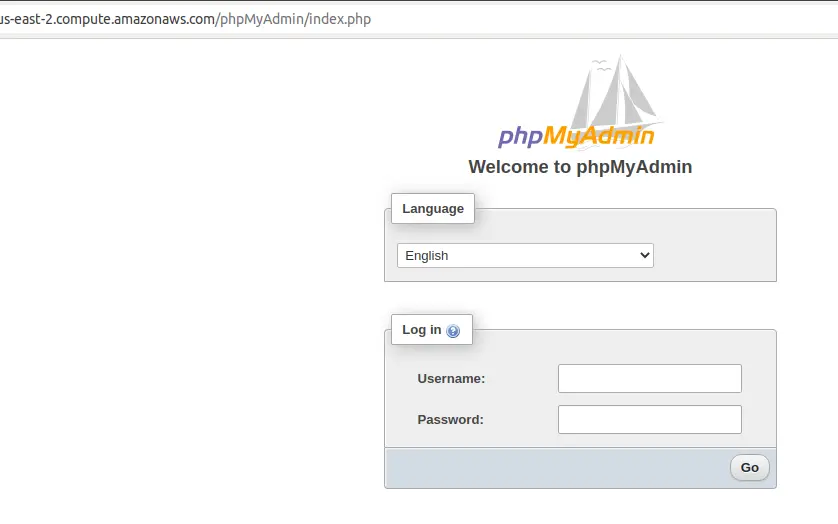

- #AWS BITNAMI PHPMYADMIN HOW TO#
- #AWS BITNAMI PHPMYADMIN INSTALL#
- #AWS BITNAMI PHPMYADMIN UPDATE#
I used the the bncert-tool and my installation commands looked like: wget -O bncert-linux-圆4.run

#AWS BITNAMI PHPMYADMIN INSTALL#
Lastly I was informed that they wanted to have a secure site, so I also used my knowledge of Bitnami to install SSL certificates to terminate on the production instance, to be sure I backed up the instance in case of failure.
#AWS BITNAMI PHPMYADMIN UPDATE#
update mdl_user set password = md5('*****') where username = '*****' ģ. I used the following SQL expression to update the password, I added ****** in place of my sensitive information. Moodle is a platform that allows educators to create online learning programs to teach remote students. I also searched for mdl_user table to get access to my test server’s login information for Moodle. After getting access to the SQL server, I exported the data immediately. Would be up to date but it wasn't working, the wrong commands were:ĪLTER USER IDENTIFIED BY 'NEW_PASSWORD' Ģ. #I kept using the newer code because I though this MySql program UPDATE er SET Password=PASSWORD('NEW_PASSWORD') WHERE User='root'
#AWS BITNAMI PHPMYADMIN HOW TO#
I learned about how to read the log files to determine when my syntax was off or if my command was not recognized.
Access the SQL database using PHPMyAdmin, this required me to reset the database username and password, after looking around online I figured out that this involved creating a Mysql-init file with the following code to reset the password. Today I was able to get the following accomplished Make the system leaner and more highly available with a serverless architecture. Apply SSL certificates to terminate on their locally hosted EC2 Moodle Bitnami server, whose domain hosting is on Bluehost. I volunteered my time and was given two tasks Password: application password that was just set or if you don’t know or can’t remember.I work as a volunteer for a non-profit organization called the Ahmadiyya Muslim Community, they mainly focus on humanitarian along with religious activities and currently they needed help with their AWS systems. Log in to phpMyAdmin by using the following credentials:.  Access the phpMyAdmin console through the secure SSH tunnel you created, by browsing to. The SSH session will now include a secure SSH tunnel between the two specified ports. Click the “Open” button to open an SSH session to the server. In the “Session” section, save your changes by clicking the “Save” button. (You’ll see the added port in the list of “Forwarded ports”). Click the “Add” button to add the secure tunnel configuration to the session. This will create a secure tunnel by forwarding a port (the “destination port”) on the remote server to a port (the “source port”) on the local host (127.0.0.1 or localhost). In the “Connection -> SSH -> Tunnels” section, add a new forwarded port by introducing the following values:. Once you have your SSH client correctly configured and you tested that you can successfully access to your instance via SSH, you need to create an SSH tunnel in order to access phpMyAdmin. Please, check how to configure it in the section how to connect to the server through SSH using an SSH client on Windows. The first step is having PuTTY configured. In the instructions below we have selected PuTTY, a free SSH client for Windows and UNIX platforms. In order to access phpMyAdmin via SSH tunnel you need an SSH client.
Access the phpMyAdmin console through the secure SSH tunnel you created, by browsing to. The SSH session will now include a secure SSH tunnel between the two specified ports. Click the “Open” button to open an SSH session to the server. In the “Session” section, save your changes by clicking the “Save” button. (You’ll see the added port in the list of “Forwarded ports”). Click the “Add” button to add the secure tunnel configuration to the session. This will create a secure tunnel by forwarding a port (the “destination port”) on the remote server to a port (the “source port”) on the local host (127.0.0.1 or localhost). In the “Connection -> SSH -> Tunnels” section, add a new forwarded port by introducing the following values:. Once you have your SSH client correctly configured and you tested that you can successfully access to your instance via SSH, you need to create an SSH tunnel in order to access phpMyAdmin. Please, check how to configure it in the section how to connect to the server through SSH using an SSH client on Windows. The first step is having PuTTY configured. In the instructions below we have selected PuTTY, a free SSH client for Windows and UNIX platforms. In order to access phpMyAdmin via SSH tunnel you need an SSH client.







 0 kommentar(er)
0 kommentar(er)
